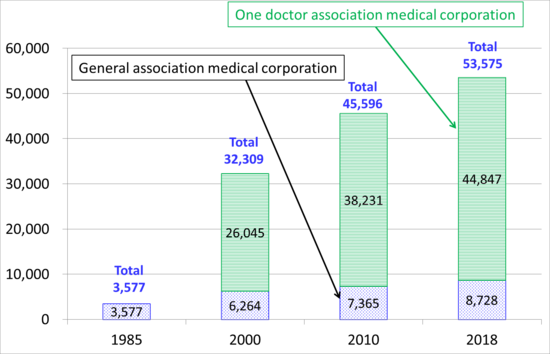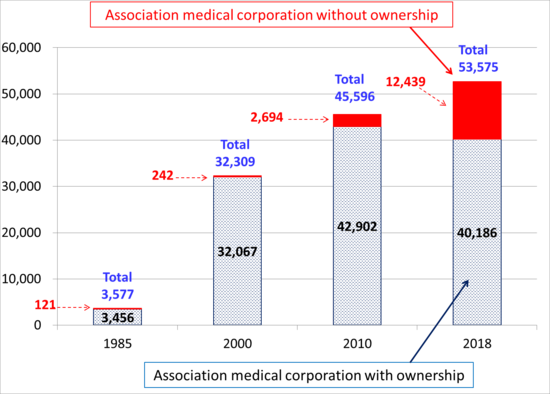Column Finance and the Social Security System 2019.06.17
【Aging, safety net and fiscal crisis in Japan】No.197: Types of Medical Corporations
Medical institutions established by doctors and dentists are recognized, by medical law, as having their own legal personalities and, in turn, as medical corporations. There exist both foundations and associations as organizational forms of medical corporations. A foundation, which is a collection of property that is owned for a specific purpose, is an organization managed and operated for the benefit of the public. An association, which is an organization composed of a plurality of people connected for a certain purpose, acts as a single social entity with a particular intention. As shown in Figure 1, the number of medical corporations was 3,926 in 1985, which has since increased to 53,944 in 2018. Of this, 53,575 are medical corporations organized as associations.
As an association is defined as a group of people, it cannot be established by only one person. However, the medical law was revised in 1985, making it possible for a single doctor or dentist to establish an association medical corporation (AMC). This measure was aimed at stabilizing the management of clinics. As shown in Figure 2, the reason for the increase in AMCs in recent years is that the number of those begun by a single doctor has increased drastically.
An AMC is a private property owned by a doctor or dentist, with the profit being attributed to them. However, medical law does prohibit this style of association from paying out the profits obtained by the business, in order to ensure that the non-profit nature of medical institutions is maintained. However, the sponsor is able to monetize their previously accumulated profits through selling the corporation. Therefore, even if it is not possible for the association owner to receive a dividend every year, it is possible for them to receive a payout later on through selling the corporation. Criticism for this loophole within medical law originated from the business community, who insists on admitting the stock corporation hospital. As a result, medical law was amended in 2006, with newly established associations being limited to organizations that have abandoned the right to exist as a private property of the sponsor. This is referred to as an AMC without ownership, and is distinguished from the conventional ones with ownership. As shown in Figure 3, only AMCs without ownership have recently increased in numbers. However, 40,186, accounting for 75% of the total, are recognized as those with ownership. In addition, even if it is an AMC without ownership, the sponsor doctor or dentist can freely decide their salary, and, as a result, be regarded as a private property owner.



